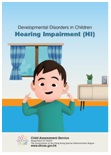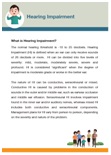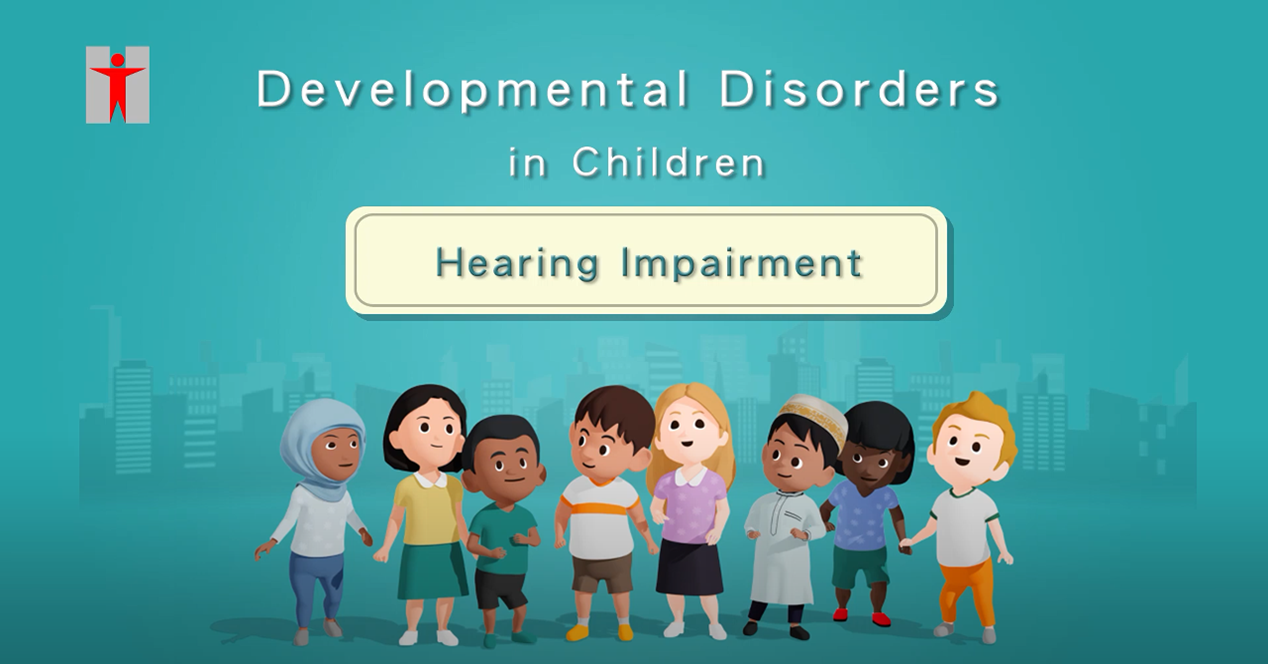Hearing Impairment
The normal hearing threshold is -10 to 25 decibels. Hearing Impairment (HI) is defined when an ear can only receive sounds of 26 decibels or more. HI can be divided into five levels of severity: mild, moderate, moderately severe, severe and profound. HI is considered ‘significant’ when the degree of impairment is moderate grade or worse in the better ear.
The nature of HI can be conductive, sensorineural or mixed. Conductive HI is caused by problems in the conduction of sounds in the outer and/or middle ear, such as earwax occlusion and middle ear effusion. Sensorineural HI involves impairment found in the inner ear and/or auditory nerves, whereas mixed HI includes both conductive and sensorineural components. Management plans for HI vary from person to person, depending on the severity and nature of the problem.
Auditory function:
The impact of HI follows the degree and nature of impairment. Children with mild HI demonstrate difficulty perceiving faint sounds and understanding soft-spoken speech. Children with moderate HI demonstrate understanding of speech at 3-5 feet distance but they have difficulty in perceiving conversation in a noisy environment, while those with severe HI can only understand speech at 1 foot from the ear with poor speech sound discrimination. Children with profound HI generally show a lack of response to environmental sounds and they cannot rely on hearing as their primary modality of communication.
Language development:
HI affects different stages of language development, the development of verbal communication depends on the severity and the onset time of HI. The following descriptions refer to the language development of children with early onset of significant HI since the pre-verbal stage.
- Pre-verbal stage (Babbling Stage)
Most children with normal hearing typically start cooing at around 2 to 3 months old. At around 6 months of age, most of them produce early consonant-vowel combinations such as “baba” and “mama”. The pre-verbal development of children with HI usually parallels with their normal-hearing counterparts at this stage. However, due to the lack of auditory feedbacks, most of the children will gradually stop babbling eventually. - Single-word stage
Most normal-hearing children produce their first words at around 1 year old, their vocabulary size will then progress at a rapid pace. Children with HI, however, have a much slower rate of vocabulary acquisition. - Combined-word stage / Grammatical acquisition
Most normally developing children start to say 2-word combinations such as “eat bread”, “play car” at around 2 years old. Children with HI, depending on their severity, normally produce these phrases at a later age. Research has shown that the milestones of grammatical development in children with HI parallel with their normal-hearing counterparts but at a slower pace of further acquisition. They have more difficulties in understanding and producing complex grammatical structures. Using English language as an example, children with HI may have trouble identifying some high frequency sounds such as “s” or “ed”. Therefore, they may also have problems in acquiring the meaning and usage of these grammatical markers. - Speech sound development
Hearing impairment will affect speech perception and thereby compromises the phonological development. Children with high frequency HI will find it difficult to acquire phonemes such as “s” (as in “smile”) and “f” (as in “flower”). Difficulties in controlling their prosody are also reported in the population.
Cognitive development:
HI itself does not hinder cognitive development but the communication and language development of children with HI will be affected. The lack of a solid first language (sign or spoken) and of interactive learning experience will affect acquisition of information and knowledge. These children may, as a result, fail to fulfill their full potentials.
Literacy:
Many studies have shown that children with HI are at risk of weaker literacy development. Under the influence of HI, a delay in the early phonological development and the growth of vocabularies and grammatical development are often observed. Children with severe HI do not have a solid knowledge of the sounds of words, and hence are unable to “read out the words” in their brains. Reading and comprehension will therefore be more difficult without the foundation of a fluent first language.
Psychosocial development:
As the result of HI, children are less keen to communicate and interact with others, thus hampering the relationship with their caregivers and friends. Emotional or behavioral problems in older children may appear due to ineffective communication with peers and low self-esteem.
Motor development:
Motor coordination problems are spotted in children with severe to profound HI. They may lose balance and more likely to fall in daily activities, such as standing on uneven grounds, walking or jogging; in some cases, they may even fall off the chairs while sitting. These problems are often more obvious in a dark environment.
Data of overseas studies shows that the prevalence of congenital HI varies from 1-3 per 1000 newborn infants. There are around 60-70 children diagnosed with significant HI every year at Child Assessment Service (CAS) of Department of Health (DH) in Hong Kong.
Genetic causes account for roughly 50-60% of children with HI but most cases are autosomal recessive. These include gene mutations, chromosomal abnormalities and genetic syndromes. Studies reveal that many genes are related to HI, with some causing mild HI and others significant HI. Common genetic mutation testing is provided by the Clinical Genetic Service of DH.
Meanwhile, many non-genetic factors can also lead to HI. Sensorineural HI may result from multiple causes, including intrauterine infections or certain drugs taken by the pregnant mother, adverse events during delivery, brain and ear infections, as well as trauma or tumors affecting related structures during infancy and childhood. Conductive hearing loss may result from infection or obstruction of the ear canal and middle ear, such as impacted ear wax and secretory otitis media.
Some developmental conditions commonly seen in children may be confused with HI. These include autism spectrum disorder, severe language delay, developmental delay or intellectual disability and severe behavioral disorders.
Depending largely on the cause of the HI, there may also be developmental delay, intellectual disability, emotional and behavioral problem, cerebral palsy or visual impairment in respective children with HI. HI may also be part of the features of congenital syndromes in which hearing is affected.
Auditory training:
Residual hearing should be optimized through early amplification, provisions of favorable acoustic environment and appropriate training. Effective comprehensive habilitation programs will be able to enhance these children’s auditory awareness and speech discrimination ability, foster the development of speech and language, and facilitate their intellectual and social development.
Language and communication training:
Children with HI generally are required to receive training in their language and communication due to the impacted development of their verbal language. The earlier the commencement of training, the better the outcome will be. However, the ultimate progress will also depend on other factors, including the degree of hearing impairment, how long it has taken for hearing aids or cochlear implants to be effectively fitted, the learning abilities of the child, motivation of the parents, and so on.
Some children with HI may not attain a satisfactory level of verbal language development even though they have been fitted with hearing aids or cochlear implant. Therefore, in these cases, the therapists might need to consider other modes of non-communication. In Hong Kong, most of the aural rehabilitation programs use total communication as the basic concept. Recently, the concept of sign-oral language bilingualism has also been put into the rehabilitation programs. Auditory-verbal therapy and the cued-speech method are also widely used in western countries. Below are some descriptions of the aforesaid rehabilitation methods:
- Total communication approach
This approach focuses on the use of residual hearing, sound discrimination and identification, speech perception, verbal comprehension and expression in daily communication. It also advocates the use of signs and lip-reading to facilitate communication and learning. Total communication encourages the use of all modes, namely speech, signs, lip-reading and writing, to facilitate communication. - Sign-oral language bilingual approach
This approach advocates children with HI to learn both sign and oral languages for communication in order to maximize language development. Research has shown that acquiring the first language through sign language does not hinder their oral language acquisition, on the contrary, enhance their overall language abilities, and support the development of both verbal and written forms of language. The use of sign-oral bilingualism is crucial during the critical period of language development at the early life of children with HI, especially when their hearing is very limited/insufficient. This bilingual approach will support effective development of language, concepts and social skills. Some kindergartens, primary and secondary schools in Hong Kong employ this rehabilitation approach in their curriculum. Teachers incorporates sign and oral languages simultaneously in their teaching. - Auditory-verbal therapy
Most parents of children with HI have normal hearing, besides, with advances in technology, hearing aids and cochlear implants are often effective in helping these children acquire reasonable hearing abilities. Most parents, therefore, prefer to focus on training verbal language as the main mode of communication for their children. Auditory-verbal therapy promotes the concept of fully utilizing one’s residual hearing and learning verbal language as the only mode of communication. This approach does not encourage the use of lip-reading. Parents are trained to provide environmental accommodations, to promote the awareness of children to auditory stimuli in daily activities, and to enhance their verbal comprehension and expression.
Learning strategy:
Developing a fluent first language at an early age will help facilitate a child’s development of cognition and written language. When reading, children need to use existing knowledge and a "top down" approach to understand the content. At the same time, children may need to use the "bottom up" approach through the reading of words and sentences to understand the article and learn new concepts. In addition, we can enhance children's reading motivation through interesting learning activities, reading different kinds of books, and use of multi-sensory methods to help word learning, promote grammar learning and enrich their background knowledge.
Medical treatment:
Treatment of the underlying cause of hearing loss is possible in some conditions (e.g. earwax removal, antibiotics for otitis media, grommet insertion for middle ear effusion). Besides, genetic counselling or related medical treatment can be provided for genetic and syndromal conditions.
Hearing aids and assistive listening devices:
With overwhelming research evidence demonstrating the benefit of early amplification on language development, children with HI should be fitted with hearing aids as early as possible. Binaural use of hearing aid is recommended for more effective reception of auditory signals and for better localization of sounds. However, even with advanced hearing aids, hearing cannot be fully restored. Children must receive appropriate auditory training in order to facilitate speech and language development. In noisy environments, digital wireless transmission systems and other assistive listening devices may be used together with hearing aids to reduce the impact of noise.
Cochlear implant and auditory brainstem implant:
For children with severe to profound hearing loss who show limited or no benefit from hearing aids, cochlear implantation (CI) may be considered. A cochlear implant is a surgically implanted electronic device that allows the recipient to receive auditory information by electrical stimulation of the cochlear. Another audiological intervention would be auditory brainstem implant (ABI), which is used to treat total deafness in both ears that cannot be improved by hearing aids or cochlear implants. The external receivers of CI and ABI are similar, but in ABI, the internal device is connected to the brainstem and directly stimulates the cochlear nucleus. Both CI and ABI require intensive auditory, speech and language rehabilitation and training after the surgical intervention.
Psychosocial support for parents and children:
Professional advice, counseling and psychological support must be provided to parents of children with HI. Their compliance with the child’s use of hearing aids, provision of adequate language stimuli and participation in parent support groups should be encouraged. Advice on school accommodations, such as classroom seating arrangement, and regular reviews of the child’s hearing status should be given.
Early identification:
Family Health Service from DH and neonatal units from the Hospital Authority (HA) provide universal newborn hearing screening programs using the Distortion Product Otoacoustic Emissions and Automated Auditory Brainstem Response, respectively. Student Health Service (SHS) also provides hearing screening for Primary 1 to Form 6 students who join their voluntary annual health check program.
Diagnostic services:
Ear, Nose and Throat (ENT) Departments of HA, and Audiological services of CAS and SHS of DH provide diagnostic assessment for children with HI.
Medical and surgical treatment and assistive devices:
HA offers medical and surgical interventions for children with HI. Since 1995, three cochlear implantation centres have been established in Queen Mary Hospital, Prince of Wales Hospital and Queen Elizabeth Hospital, respectively. In current practice, the age for paediatric cochlear implantation is around 1 year old. Hearing aids and assistive listening devices can be obtained through the Education Bureau (EDB) or the private sector. Auditory and speech training is available in speech therapy clinics under HA, EDB, non-governmental organizations and the private sector.
Preschool training:
In Hong Kong, there are early educational training centres and special childcare centres, which provide pre-school habilitation training for children with HI and their parents. They emphasize on intensive auditory and speech training, and children are encouraged to practise their speech and communication skills through various activities. Moreover, integrated programmes in child care centres, as well as special child care centres for children with disabilities, are also provided with additional resources to help children with HI.
Special school for hearing impairment:
Lutheran School for the Deaf is the only special school for hearing-impaired school-aged children in Hong Kong today. It adopts the mainstream curriculum with special educational adjustments and support from teachers based on the students’ need and achievement. Total communication method is applied to create a barrier-free environment in order to facilitate a balanced development in spoken, sign and written language. There are also continual auditory and speech training at the school.
In recent years, there has been a shift in the enrolment from special schools to mainstream schools for children with HI. To help children with HI to achieve better learning outcome, the government has granted extra funding and provided educational supportive measures for the mainstream schools; special schools have also arranged outreached services.
Sign bilingualism and co-enrolment in deaf education programme:
The use of sign language together with oral language is believed to enable the children with significant HI to be better able to attain their full cognitive, linguistic and social potentials.
Since 2006, the Centre for Sign Linguistics and Deaf Studies in the Chinese University of Hong Kong has introduced “Sign Bilingualism and Co-enrollment in Deaf Education Programme” which promotes simultaneous acquisition of sign language and oral language. Besides “Sign language classes for babies”, the Centre provides “Sign bilingual Chinese reading classes” and “Parents signing classes”. The Centre partners with kindergartens, primary and secondary schools to deliver this educational programme in the school setting.
Parent support and training:
Parent resource centres, support groups and parent training programmes are provided by a wide variety of institutions including both government and non-governmental organisations, such as The Hong Kong Society for the Deaf, HA cochlear implant centres, special schools and CAS of DH, etc.
Prognosis is dependent on the degree of HI, age of onset and diagnosis, age at which amplification is introduced, developmental characteristics of the child, psychosocial factors and educational experience, etc. Early diagnosis and timely intervention are key factors for a favorable outcome.
- Education Bureau (Support for Ordinary School)
http://www.edb.gov.hk/tc/edu-system/special/support/wsa/index.html - Education Bureau (Special Education Resource Centre – Hearing Impairment)
http://www.edb.gov.hk/en/edu-system/special/resources/serc/hi.html
http://www.edb.gov.hk/attachment/en/edu-system/special/ resources/serc/download/hi_e.pdf - Hong Kong Hospital Authority
http://www.ha.org.hk/visitor/ - Social Welfare Department
http://www.swd.gov.hk - Social Welfare Department (Pre-school Rehabilitation Services/Rehabilitation and Medical Social Service Branch)
http://www.swd.gov.hk/en/index/site_pubsvc/page_rehab/ - Centre for Sign Linguistics and Deaf Studies
http://www.cslds.org/v3/?lang=en - Hong Kong Association of the Deaf
http://www.hongkongdeaf.org.hk/ - Suen Mei Speech & Hearing Centre
http://www.suenmeicentre.com/ - The Hong Kong Society for the Deaf
http://www.deaf.org.hk/ - Y’s Men’s Centre for the Deaf Chinese YMCA of Hong Kong
http://ymd.ymca.org.hk/zh-hant/ - Hong Kong Parents Association for the Hearing-impaired (HKPAHI)
http://www.facebook.com/hkpahi
- Early Hearing Detection and Intervention (EHDI) (2001). American Academy of Pediatrics (AAP).
- Joint Committee on Infant Hearing (2000). Year 2000 position statement: principles and guidelines for early hearing detection and intervention programs. Pediatrics, 106(4), 798-817.
- Joint Committee on Infant Hearing (2007). Year 2007 position statement: principles and guidelines for early hearing detection and intervention programs. Pediatrics, 120(4), 898-921.
- Ma TPY, Chan WY, Koh C, Yeung W, Wong KY, Sung J, et al. Hong Kong Universal Newborn Hearing Screening (UNHS). Care Path Protocol under Joint Committee on UNHS. HK J Paediatr (new series) 2021;26:168-174.

Short Factsheet

Long Factsheet

